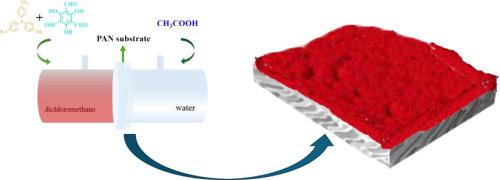Unidirectional diffusion synthesis of stabilized triphenylamine-based organic frameworks (COFs) composite membranes for dye separation
IF 8.1
1区 工程技术
Q1 ENGINEERING, CHEMICAL
引用次数: 0
Abstract
The synthesis of high-quality two-dimensional covalent organic frameworks (2D COFs) under mild conditions is crucial for their wide scale industrial application. Therefore, the advancement of the unidirectional diffusion synthesis (UDS) method has garnered significant attention. A comprehensive understanding of the diffusion dynamic occurring between the two phases is vital for optimizing reaction times and enhancing the growth conditions of highly crystalline COF films. In this work, we employed the UDS method, explored through various characterization tests, to fabricate 2D COFs on commercial PAN ultrafiltration membranes. Our study shows that the COF layer forms on one side contacting with the organic phase, regardless of whether the front side of the PAN-based film is exposed to the aqueous or organic phase. Through the different reaction times, it was found that the 2-min treatment yielded the optimal performance, with a pure water permeability coefficient of approximately 98 L·m−2·h−1·bar−1, along with a retention rate of exceeding 95 % for both CR and AR 120. Furthermore, it surpassed the interfacial polymerization method in terms of both stability and retention capacity for EBF molecules with molecular weights under 500 g·mol−1.

求助全文
约1分钟内获得全文
求助全文
来源期刊

Separation and Purification Technology
工程技术-工程:化工
CiteScore
14.00
自引率
12.80%
发文量
2347
审稿时长
43 days
期刊介绍:
Separation and Purification Technology is a premier journal committed to sharing innovative methods for separation and purification in chemical and environmental engineering, encompassing both homogeneous solutions and heterogeneous mixtures. Our scope includes the separation and/or purification of liquids, vapors, and gases, as well as carbon capture and separation techniques. However, it's important to note that methods solely intended for analytical purposes are not within the scope of the journal. Additionally, disciplines such as soil science, polymer science, and metallurgy fall outside the purview of Separation and Purification Technology. Join us in advancing the field of separation and purification methods for sustainable solutions in chemical and environmental engineering.
 求助内容:
求助内容: 应助结果提醒方式:
应助结果提醒方式:


